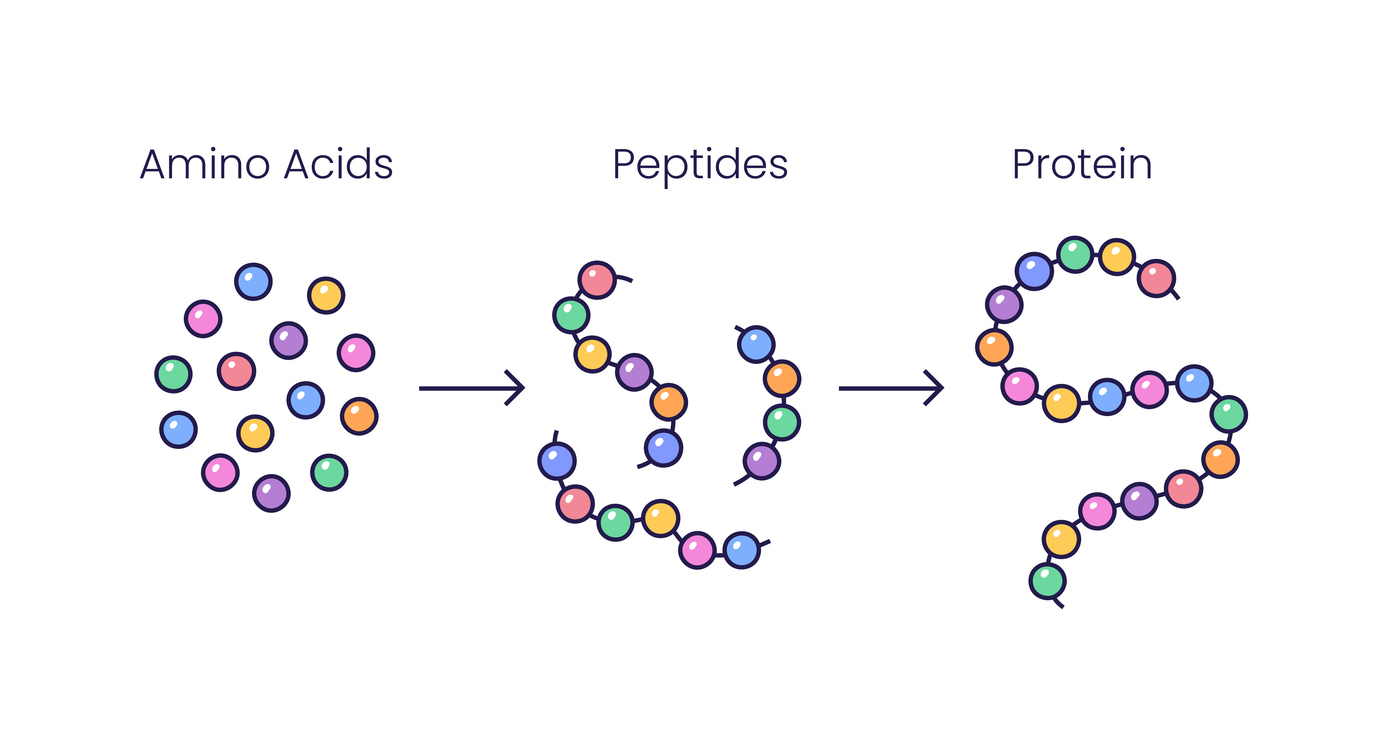
What the elite from Hollywood, Silicon Valley and the biohacking scene have long known is now becoming a game changer for the longevity movement: Peptide stacking. This strategic combination of different peptides – short amino acid chains – promises nothing less than the reversal of the ageing process.
While tech billionaires and A-list celebrities are investing millions in this molecular revolution, a new market for customized anti-aging protocols is emerging. But what exactly is behind this trend that is generating increasing enthusiasm?
Peptide stacking: the science behind molecular anti-ageing
Peptide stacking involves the strategic combination of several peptides in a uniform treatment regimen in order to specifically enhance their collective effect. Peptides are short chains of amino acids, i.e. the basic building blocks of proteins. While proteins usually consist of hundreds or thousands of amino acids, peptides typically consist of 2 to about 50 amino acids linked by peptide bonds.

Instead of using individual peptides, they are combined in synergistic “stacks” that target specific body systems.
Professor Vladimir Khavinson, one of Russia’s most respected gerontology researchers, has a fascinating theory: many ageing processes are caused by the continuous breakdown of proteins in tissues and organs. Peptides can replenish these stores and stimulate protein synthesis – meaning you can actually repair as you age instead of succumbing to the usual protein breakdown.
The ultimate longevity stack: the elite use these peptides
Probably the best-known longevity stack combines several powerhouse peptides: epithalon, MOTS-C, GHK-Cu, humanin and other specialized molecules. Each of them has a specific effect on cellular ageing processes, but together they unfold their full regenerative potential.
Epithalon: the primary anti-ageing peptide
Epithalon is considered the crown jewel among the longevity peptides. It is one of the few synthesized compounds that has been shown to directly activate the telomerase enzyme in humans. Why is this revolutionary? Telomerase renews and lengthens telomeres – the protective caps at the ends of your chromosomes that get shorter with each aging process.
By activating telomerase, epithalon can reduce telomere shortening and theoretically help to “age backwards”. Typical use is in cycles of 10-20 days with doses between 5-10 mg daily, administered either subcutaneously or intramuscularly.
Biohackers and longevity enthusiasts report amazing results: improved sleep, increased energy, faster recovery and even visible skin rejuvenation. But the real potential lies in the long-term effect on the biological clock.
BUT: The research situation is still weak
- Animal studies: Show life extension, improved stress resistance and tumor inhibition.
- Clinical studies (Russia): Smaller studies on older people indicate positive effects on immune function, sleep quality and general health.
- Western science: To date, there are hardly any large randomized studies outside Russia.
This means: promising, but not internationally validated.
MOTS-C: “Training in a bottle”
MOTS-C is called “training in a bottle” for a reason. This mitochondrial peptide activates the AMP-K signaling pathway – the same metabolic pathway that is stimulated by intense exercise. It improves insulin sensitivity, promotes mitochondrial function and enhances autophagy – the cellular cleansing process that recycles damaged cellular components.
As there are no approved human studies, safety and long-term effects are unknown.
The main risks lie in
- unregulated sources (contamination, incorrect dosing)
- unpredictable effects on the metabolism and hormone system
- lack of data on cancer risk (due to growth and metabolic stimulation)
Who uses peptide stacking? From Hollywood to Silicon Valley
In Hollywood and Silicon Valley, peptide stacking has long been more than just an insider tip. Celebrities, billionaires and longevity investors have integrated peptides into their personal longevity protocols. Since the end of last year, the popularity of Google searches for “peptides” in the USA has risen by almost 60% – a clear sign of the change “from something obscure to something normal”.
Risks and medical monitoring: what you need to know!
Peptides are biologically highly active substances – their use carries risks if they are used uncontrolled or improperly. Possible side effects include local irritation at the injection site, fatigue or headaches. More serious are the dangers posed by products from unsafe sources: Peptides from the black market or from questionable online stores can be contaminated, incorrectly dosed or even counterfeit.
In Europe, most therapeutically used peptides are prescription drugs and may only be prescribed by doctors. Many of the substances popular in the biohacking scene are not officially approved. Production and distribution therefore often take place in a legal gray area.
Medical supervision is therefore essential: peptides should only be used under the supervision of a doctor who is experienced in functional or longevity medicine. This is the only way to responsibly assess the benefits, safety and quality of the substances.
The molecular future of anti-ageing
Peptides are at the forefront of personalized, results-oriented longevity treatments. As research progresses, the products become smarter, the users more informed and the results more impressive. They offer a unique approach to longevity – potentially more effective, more holistic and safer than traditional treatments.
In the coming years, peptides are likely to further expand their key role in longevity medicine. With more research and development, we can expect even more precise stacks and better results from these powerful molecules.
What was once considered an inevitable biological process is increasingly seen as a changeable biochemical equation. Peptide stacking gives you the opportunity to change this equation in your favor.
Sources:
bengreenfieldlife.com – The Best Peptide Stacks for Recovery, Fat Loss, Anti-Aging, and More
Wang L, Wang N, Zhang W, Cheng X, Yan Z, Shao G, Wang X, Wang R, Fu C. Therapeutic peptides: current applications and future directions. Signal Transduct Target Ther. 2022 Feb 14;7(1):48. doi: 10.1038/s41392-022-00904-4. PMID: 35165272; PMCID: PMC8844085.
semafor.com – ‘Peptides’ are the latest longevity trend in Silicon Valley
fortune.com – Tech bros like Bryan Johnson are spending millions to shoot for immortality
townandcountrymag.com – The Latest 2025 Beauty Trend for the Wealthy: Stacking Peptide Injectables
hubermanlab.com – Benefits & Risks of Peptide Therapeutics for Physical & Mental Health
🩺 Medically tested
This article has been professionally reviewed by Dr. Verena Immer. She is a doctor of integrative and anti-ageing medicine with a holistic approach that combines conventional medical knowledge with complementary methods. She has successfully applied the concept of individualized medicine in her own practice near Munich and currently offers personalized medicine – with a focus on longevity – in Switzerland.
Image source: istockphoto.com
Vector Illustration of Amino acids structure, peptides and proteins | credits @ Vitalii Dumma
Disclaimer
This blog is for general informational purposes only and does not constitute the practice of medicine, nursing or other professional health care services, including the giving of medical advice, and no doctor-patient relationship is established. Use of any information contained in this blog or materials linked to this blog is at the user’s own risk. The content of this blog is not intended as a substitute for professional medical advice, diagnosis or treatment. Users should not ignore or delay medical advice for any medical conditions they may have and should seek the help of their healthcare professional for such conditions.










